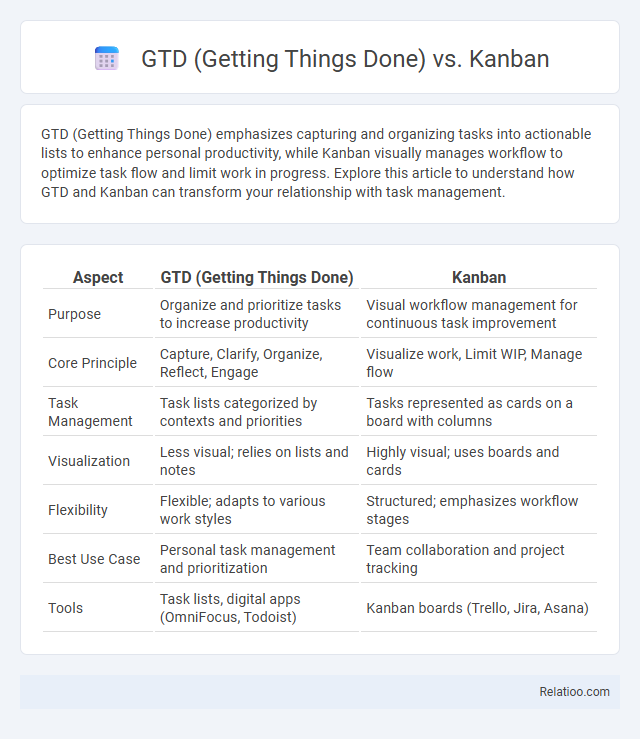GTD (Getting Things Done) emphasizes capturing and organizing tasks into actionable lists to enhance personal productivity, while Kanban visually manages workflow to optimize task flow and limit work in progress. Explore this article to understand how GTD and Kanban can transform your relationship with task management.
Table of Comparison
| Aspect | GTD (Getting Things Done) | Kanban |
|---|---|---|
| Purpose | Organize and prioritize tasks to increase productivity | Visual workflow management for continuous task improvement |
| Core Principle | Capture, Clarify, Organize, Reflect, Engage | Visualize work, Limit WIP, Manage flow |
| Task Management | Task lists categorized by contexts and priorities | Tasks represented as cards on a board with columns |
| Visualization | Less visual; relies on lists and notes | Highly visual; uses boards and cards |
| Flexibility | Flexible; adapts to various work styles | Structured; emphasizes workflow stages |
| Best Use Case | Personal task management and prioritization | Team collaboration and project tracking |
| Tools | Task lists, digital apps (OmniFocus, Todoist) | Kanban boards (Trello, Jira, Asana) |
Introduction to GTD and Kanban
GTD (Getting Things Done) is a productivity methodology developed by David Allen that emphasizes capturing, organizing, and reviewing tasks to reduce stress and increase efficiency. Kanban, originating from lean manufacturing and popularized in software development, uses visual boards with cards to represent work items, allowing teams to manage workflow and limit work in progress. Both GTD and Kanban improve task management but differ in approach: GTD focuses on personal task tracking through lists and reviews, while Kanban centers on visualizing and managing work stages through boards.
Core Principles of GTD
GTD (Getting Things Done) centers on capturing all tasks and commitments in a trusted system to reduce mental clutter, emphasizing clear next actions and regular reviews to maintain focus and productivity. Unlike Kanban, which visually manages work-in-progress through boards and cards to optimize flow, GTD prioritizes detailed organization and context-based task processing to enhance decision-making and execution. Confirmation, often tied to feedback processes, differs by validating task completion and outcomes, while GTD's core lies in proactive task management and workflow mastery for stress-free productivity.
Core Principles of Kanban
Kanban's core principles emphasize visualizing work, limiting work in progress, managing flow, making process policies explicit, implementing feedback loops, and improving collaboratively and experimentally. Visual boards help teams monitor tasks, while WIP limits prevent overload and enhance focus on completing work before starting new items. This system prioritizes continuous delivery and adaptability, differing from GTD's task capture and organization focus and Confirmation's emphasis on decision validation.
Workflow Structures: GTD vs Kanban
GTD (Getting Things Done) centers on capturing and organizing tasks into discrete lists and contexts, enabling clear next actions and reducing mental clutter. Kanban emphasizes visual workflow management through boards and cards, allowing you to monitor task progress and limit work in progress to enhance efficiency. Your choice between GTD's list-based structure and Kanban's visual task flow depends on whether you prioritize task categorization or real-time process monitoring.
Task Management Approaches Compared
GTD (Getting Things Done), Kanban, and Confirmation represent distinct task management approaches that cater to different productivity needs and workflows. GTD emphasizes capturing all tasks in a trusted system and processing them through clear next actions, enhancing your mental clarity and focus. Kanban uses visual boards to balance work in progress and optimize flow, while Confirmation relies on validating completed tasks to ensure quality and accountability.
Flexibility and Adaptability
GTD (Getting Things Done) offers a structured yet flexible framework that adapts to your evolving tasks by capturing and organizing commitments in an actionable system, enhancing personal productivity. Kanban provides visual workflow management with customizable boards and real-time adaptability, allowing you to easily reprioritize tasks and respond to changing demands. Confirmation, as a process, emphasizes validating completion and progress, which can be integrated within both approaches to ensure task accuracy and maintain project momentum.
Tools and Techniques for Implementation
GTD (Getting Things Done) uses a workflow system centered on capturing, clarifying, organizing, reflecting, and engaging tasks, often supported by tools like Todoist or OmniFocus that facilitate task management and context tagging. Kanban employs a visual board with columns representing workflow stages, using tools such as Trello or Jira to track work-in-progress limits and optimize task flow. Confirmation, as a technique, emphasizes validating task completion and commitment through regular reviews or check-ins, which you can implement with tools like Habitica or daily journaling apps to reinforce accountability and progress tracking.
Strengths and Weaknesses of Each System
GTD (Getting Things Done) excels in managing complex task workflows through a detailed capture, clarify, organize, reflect, and engage framework, but it can be overwhelming due to its detailed processing steps. Kanban offers visual task tracking with real-time work-in-progress limits that enhance workflow efficiency and reduce bottlenecks, yet it may lack the granular task categorization found in GTD. Confirmation, focusing on decision validation and commitment, strengthens accountability and reduces error risk but can slow down progress due to the need for multiple verification stages.
Choosing the Right Method for Your Needs
Choosing the right productivity method depends on individual workflow preferences and task complexity. GTD (Getting Things Done) emphasizes capturing and organizing tasks for clear prioritization, making it ideal for those managing diverse responsibilities and looking for a systematic approach. Kanban provides a visual workflow with task progress tracking, suited for teams and projects requiring real-time updates, while Confirmation focuses on validating task completion and deadlines, benefiting users who need accountability and frequent progress checks.
Conclusion: Integrating GTD and Kanban
Integrating GTD and Kanban enhances productivity by combining GTD's structured task capture and prioritization with Kanban's visual workflow management and real-time progress tracking. This hybrid approach enables clearer task organization, reduces cognitive load, and improves focus by systematically moving tasks through defined stages. Adopting both methodologies promotes efficient work execution and adaptability to changing priorities in personal and professional settings.

Infographic: GTD (Getting Things Done) vs Kanban
 relatioo.com
relatioo.com